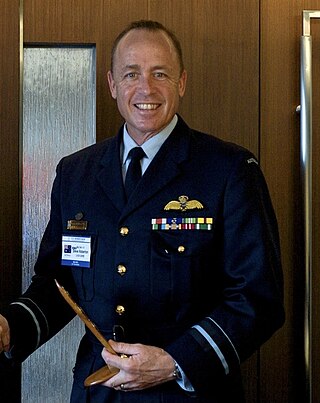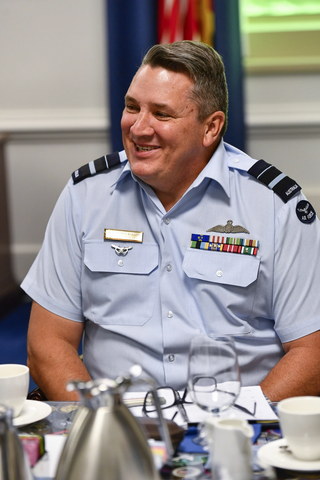
The Royal Australian Air Force (RAAF) is the principal aerial warfare force of Australia, a part of the Australian Defence Force (ADF) along with the Royal Australian Navy and the Australian Army. Constitutionally the Governor-General of Australia is the de jure Commander-in-Chief of the Australian Defence Force. The Royal Australian Air Force is commanded by the Chief of Air Force (CAF), who is subordinate to the Chief of the Defence Force (CDF). The CAF is also directly responsible to the Minister for Defence, with the Department of Defence administering the ADF and the Air Force.

Air Marshal Geoffrey David Shepherd is a retired senior officer in the Royal Australian Air Force (RAAF), who served as Chief of Air Force from 2005 until 2008.

The Royal Australian Air Force's Air Combat Group (ACG) is the group which administers the RAAF's fighter and bomber aircraft. ACG was formed on 7 February 2002 by merging the RAAF's Tactical Fighter Group and Strike Reconnaissance Group in an attempt to improve the speed with which the RAAF can deploy its combat aircraft.

Air Chief Marshal Sir Neville Patrick McNamara, was a senior commander of the Royal Australian Air Force (RAAF). He served as Chief of the Air Staff (CAS), the RAAF's highest-ranking position, from 1979 until 1982, and as Chief of the Defence Force Staff (CDFS), Australia's top military role at the time, from 1982 until 1984. He was the second RAAF officer to hold the rank of air chief marshal.

Air Vice Marshal William Dowling Bostock, was a senior commander in the Royal Australian Air Force (RAAF). During World War II he led RAAF Command, the Air Force's main operational formation, with responsibility for the defence of Australia and air offensives against Japanese targets in the South West Pacific Area. His achievements in the role earned him the Distinguished Service Order and the American Medal of Freedom. General Douglas MacArthur described him as "one of the world's most successful airmen".

Air Chief Marshal Mark Donald Binskin, is a senior officer in the Royal Australian Air Force Reserve. He served as Chief of Air Force (2008–11), Vice Chief of the Defence Force (2011–14), and Chief of the Defence Force from June 2014 until his retirement in July 2018. In February 2020 he was appointed as a Commissioner and Chairman of the Royal Commission into National Natural Disaster Arrangements. He is the current chair of the Civil Aviation Safety Authority of Australia.
Air Vice Marshal Alfred John Quaife, AM is a retired senior officer of the Royal Australian Air Force (RAAF).

Air Marshal Sir Charles Frederick Read, KBE, CB, DFC, AFC was a senior commander in the Royal Australian Air Force (RAAF). He served as Chief of the Air Staff (CAS) from 1972 to 1975. Born in Sydney, Read joined the RAAF in 1937, and began his career flying biplane fighters. As a Beaufighter pilot, he led No. 31 Squadron and No. 77 Wing in the South West Pacific during World War II. His achievements earned him the Distinguished Flying Cross and a mention in despatches, and he finished the war an acting group captain.

Air Vice Marshal Allan Leslie Walters, CB, CBE, AFC was a senior commander in the Royal Australian Air Force (RAAF). Born in Victoria and raised in Western Australia, he graduated from the Royal Military College, Duntroon, before transferring to the RAAF in 1928. He was one of the service's leading flying instructors and aerobatic pilots between the wars, and was appointed to his first squadron command in 1937. Over the course of World War II, Walters led No. 1 Squadron in Singapore, No. 1 (Fighter) Wing in Darwin, Northern Territory, No. 72 Wing in Dutch New Guinea, and Northern Command in Papua New Guinea. He was decorated with the Air Force Cross in 1941 for his work with No. 1 Squadron, and mentioned in despatches in 1944 for his service with No. 72 Wing.

Air Marshal Melvin Ernest Glanville Hupfeld, is a retired senior officer of the Royal Australian Air Force. He served as Air Commander Australia from 2012 to 2014 and was the acting and final Chief Capability Development Group (2015–16), before being appointed as Head Force Design in the Vice Chief of the Defence Force Group (2016–18). He was promoted air marshal and made Chief of Joint Operations in May 2018, and succeeded Air Marshal Leo Davies as Chief of Air Force in July 2019.

Air Marshal Gavin Neil "Leo" Davies, is a retired senior officer of the Royal Australian Air Force (RAAF). A navigator who retrained as a pilot, he joined the RAAF in 1979, commanded No. 1 Squadron RAAF (2002–03) and No. 82 Wing RAAF (2004–05), deployed to Iraq in 2007, and was Australia's air attaché in Washington, D.C. (2010–11). He served as Deputy Chief of Air Force from 2012 to 2015 and succeeded Air Marshal Geoff Brown as Chief of Air Force, the professional head of the RAAF, in July 2015. He retired from the RAAF in July 2019.
Air Marshal Warren George McDonald, is a retired senior officer of the Royal Australian Air Force (RAAF). He joined the RAAF as a 15-year-old apprentice and, in 1989, underwent pilot training. A series of squadron and staff postings in Australia, Canada and Malaysia followed, before he was appointed to command No. 11 Squadron (2007–09), No. 92 Wing (2009–11) and Air Mobility Group (2013–15). He was Deputy Chief of Air Force from July 2015 to May 2017 and the inaugural Chief of Joint Capabilities from July 2017 to November 2020.
Air Vice Marshal Tracy Lee Smart, is an Australian physician, medical administrator, and a retired senior officer in the Royal Australian Air Force (RAAF). She served as Commander of Joint Health Command and Surgeon General of the Australian Defence Force from December 2015 to December 2019. Smart was the third woman to reach the rank of air vice marshal in the RAAF.
Air Vice Marshal Gavin Alexander Turnbull, is a retired senior commander in the Royal Australian Air Force (RAAF). He joined the RAAF in 1984, trained as a helicopter pilot, and transferred to fast jets in 1991. He has commanded No. 77 Squadron RAAF (2002–04), No. 81 Wing RAAF (2007–11) and the 609th Combined Air Operations Centre (2012), and deployed on operations to the Sinai Peninsula, Iraq and Afghanistan. He served as Air Commander Australia from 2014 to 2017, and Deputy Chief of Air Force from May 2017 to July 2019.

Air Vice Marshal Steven Peter "Zed" Roberton, is a retired senior commander of the Royal Australian Air Force (RAAF). He joined the RAAF in 1989 and trained as a fighter pilot. He has deployed to Iraq, commanded No. 75 Squadron RAAF (2003–06) and No. 82 Wing RAAF (2010–11), and led Air Task Group 630 on operations against the Islamic State of Iraq and the Levant (2014–15). He served as commander Air Combat Group RAAF from 2015 to 2017, Air Commander Australia from 2017 to 2019, and Head Force Design within the Vice Chief of Defence Force Group from June 2019 to February 2022.

Air Vice Marshal Stephen Leslie Meredith, is a retired senior officer of the Royal Australian Air Force (RAAF). He joined the RAAF as a navigator in 1986. He has commanded No. 6 Squadron RAAF (2006–08), No. 42 Wing RAAF (2008–10), the Aerospace Operational Support Group RAAF (2014–16) and the Combined Air Operations Centre (2017), and has served on operations in the Gulf War, War in Afghanistan and in the International military intervention against ISIL. He served as Head Force Integration from 2017 to 2019, before being appointed Deputy Chief of Air Force from July 2019 to January 2023.

Air Marshal Robert Timothy Chipman, is a senior officer in the Royal Australian Air Force (RAAF). He joined the RAAF as an aeronautical engineer in 1989 and gained his pilot's wings in 1994. He has commanded No. 75 Squadron RAAF (2006–09), the Air and Space Operations Centre (2010–12), No. 81 Wing RAAF (2013–14) and Air Task Unit 630.1 (2014), and deployed to the Middle East on Operations Slipper and Okra. He served as the Australian Military Representative to NATO and the European Union from 2019 to 2021, Head Military Strategic Commitments from 2021 to 2022 and Chief of Air Force from 2022 to 2024. Chipman took over as the Vice Chief of the Defence Force on 9 July 2024.
Air Marshal Stephen Gareth Chappell, is a senior officer in the Royal Australian Air Force (RAAF), currently serving as the Chief of Air Force. He joined the RAAF through the Australian Defence Force Academy in 1993 and gained his pilot's wings in 1998. He has deployed on Operations Falconer and Okra to Iraq, and has commanded No. 1 Squadron RAAF (2013–16) and No. 82 Wing RAAF (2018–20). He served as Head Military Strategic Commitments from July 2022 to June 2024, and was appointed Chief of Air Force on 3 July 2024.

Air Marshal Darren James Goldie, is a senior officer in the Royal Australian Air Force. He joined the RAAF through the Australian Defence Force Academy in 1993 and gained his pilot's wings in 1997. He has deployed on operations to East Timor, Iraq and Afghanistan, and has commanded No. 37 Squadron RAAF (2012–15) and No. 92 Wing RAAF (2017–18). He was Air Commander Australia from April 2022 to June 2023, and served as the inaugural National Cyber Security Coordinator from July to November 2023.
Air Vice-Marshal Glen Edward Braz, is a senior officer in the Royal Australian Air Force (RAAF). He joined the RAAF through the Australian Defence Force Academy in 1987 and gained his pilot's wings in 1991. He has deployed on Operations Falconer and Okra to Iraq, and has commanded No. 1 Squadron RAAF (2008–11), Air Task Group 630 (2015), No. 82 Wing RAAF (2015–17) and Air Force Training Group RAAF (2017–19). He served as Deputy Chief of Air Force from January to June 2023, before assuming his current appointment as Air Commander Australia.














